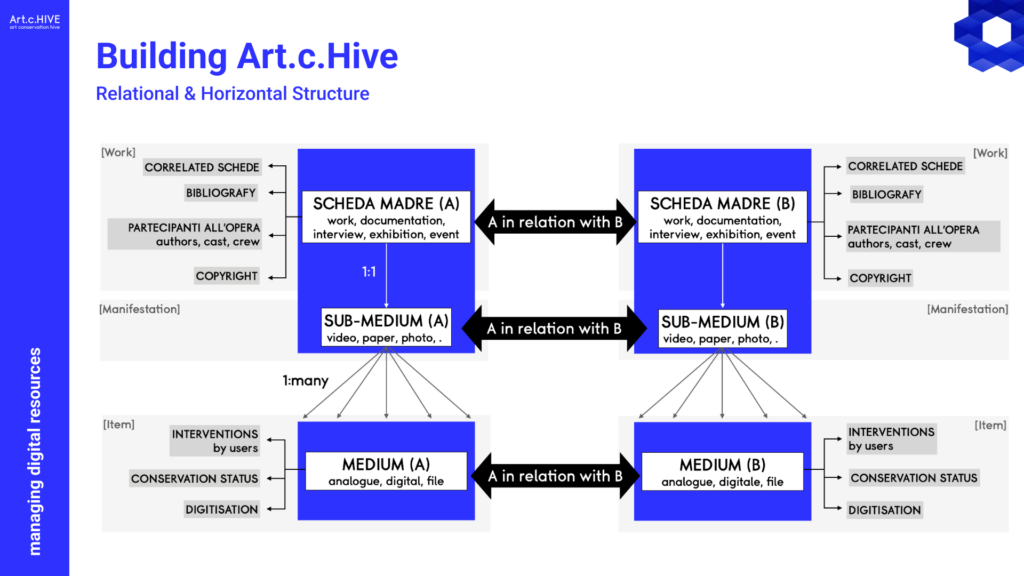From hierarchy to relations: a paradigm shift in media art cataloging and art archives.
Abstract
This paper examines the theoretical foundations and practical implications of transitioning from hierarchical to relational models in media art cataloging systems. While traditional archival approaches have relied on vertical, parent-child relationships, the complex nature of contemporary media artworks demands more flexible cataloging structures. Through analysis of existing frameworks and case studies, this research demonstrates how relational models better accommodate the fluid nature of media art, enabling more accurate representation of work variations, documentation, and preservation history.
Introduction
Contemporary media art presents unique challenges for traditional archival and cataloging systems. The inherent complexity of these works – often comprising multiple components, versions, and iterations – challenges conventional hierarchical cataloging structures. This paper examines how relational database models offer a more suitable framework for documenting and preserving media art collections.
Theoretical Framework
Traditional Hierarchical Models
Traditional archival systems typically employ a vertical structure where relationships between items are strictly hierarchical, following a parent-child model. This approach, while effective for traditional art forms, presents limitations when applied to media art:
- Rigid Structure: Hierarchical systems struggle to represent complex relationships between components
- Limited Flexibility: Modifications to established relationships require significant restructuring
- Linear Progression: Assumes a clear, linear progression from original to copies
The Relational Alternative
The relational model presents several theoretical advantages:
- Horizontal Relationships: Enables connections between elements without enforcing strict hierarchies
- Flexible Evolution: Relationships can be modified without disturbing the entire structure
- Multiple Narratives: Allows for different interpretational frameworks of the same work
- Temporal Adaptability: Can accommodate new discoveries about historical relationships
Methodology
This research analyzes existing cataloging frameworks including FRBR (Functional Requirements for Bibliographic Records), FIAF Moving Image Cataloguing Manual, and contemporary media art documentation projects. Comparative analysis focuses on their ability to represent complex media artworks and their evolution over time.
Analysis
Conceptual Shifts
The transition from hierarchical to relational models represents more than a technical change; it reflects a fundamental shift in how we conceptualize media art:
From Linear to Network Thinking
- Traditional: Original → Copy → Version
- Relational: Interconnected nodes of equal importance
From Fixed to Fluid Documentation
- Traditional: Static record of artwork state
- Relational: Dynamic documentation of ongoing evolution
From Singular to Multiple Narratives
- Traditional: One authoritative version
- Relational: Multiple valid interpretations and configurations
Practical Implications
Documentation Structure
Relational models enable:
- Multiple valid configurations of the same work
- Documentation of uncertain relationships
- Easy modification as new information emerges
- Preservation of multiple historical narratives
Conservation History
The relational approach better serves conservation needs by:
- Tracking multiple preservation copies
- Documenting relationships between versions
- Recording technical migrations
- Maintaining preservation metadata
Discussion
The shift toward relational models reflects broader changes in how we understand media art. These works often exist in multiple states simultaneously: as concept, as physical installation, as digital file, as documentation. Traditional hierarchical systems struggle to represent this multiplicity without privileging one state over others.
A relational approach acknowledges that:
- Relationships between elements may be discovered over time
- Multiple valid interpretations can coexist
- The artwork’s configuration may be fluid rather than fixed
- Documentation and preservation strategies must evolve
The potential of relational models extends far beyond media art, offering a transformative approach to art documentation across various domains. For instance, in traditional art forms like painting, a relational model could capture the intricate networks of artistic creation, including correspondence between artists and commissioners, preliminary sketches, contextual historical information, and the artwork’s provenance. Consider a painting from 1846: a relational approach would not merely catalog the final artwork, but would also document the rich exchanges between the artist and the commissioner, sketch iterations, historical context, and subsequent interpretations. This methodology allows researchers and curators to trace the genesis and evolution of an artwork, revealing complex narratives that traditional hierarchical systems might obscure. By preserving these multifaceted relationships, relational models provide a more nuanced, comprehensive understanding of art history, moving beyond static representation to a dynamic, interconnected view of artistic creation.
Conclusions
The adoption of relational models represents a necessary evolution in media art cataloging. This approach better serves the needs of contemporary art documentation while providing flexibility for future developments. It acknowledges the complex nature of media artworks and provides a more suitable framework for their documentation and preservation.




